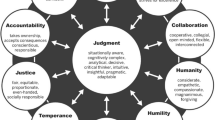Abstract
Although they differ in their explanations of the antecedents of gender-role expectations, gender role and expectation states theories agree that mixed-sex and initially leaderless task groups will confirm these expectations by selectively reinforcing male task participation and leadership emergence. Based upon this assumption held in common by the two theories, we hypothesized that groups whose members expressed significantly egalitarian gender-role expectations would reinforce male and female task participation and leadership emergence impartially. Analysis of data from 31 mixed-sex groups whose members expressed significantly egalitarian gender-role expectations, and who were racially and ethnically homogeneous, found that males participated more in group discussions and were more likely to be selected as task leaders. Male advantages were explained only partly by token effects and their advantages in task resources. Implications are suggested for theories of male and female role performance in initially leaderless groups.
Similar content being viewed by others
References
Arch, E. C. (1992). Sex differences in the effect of self-efficacy on willingness to participate in a performance situation.Psychological Reports, 70, 3–9.
Bales, R. F. (1955). How people interact in conferences.Scientific American, 192, 31–35.
Bentler, P. M., & Speckart, G. (1979). Models of attitude-behavior relations.Psychological Review, 86, 452–464.
Berger, J., Fisek, M. H., Normal, R. Z., & Zelditch, M., Jr. (1977).Status characteristics and social interaction: An expectation-states approach. New York: Elsevier.
Berger, J., Wagner, D. G., & Zelditch, M., Jr. (1985). Expectation states theory: Review and assessment. In J. Berger & M. Zelditch, Jr. (Eds.),Status, rewards, and influence: How expectations organize behavior. San-Francisco: Jossey-Bass.
Cann, A., & Siegfried, W. D. (1990). Gender stereotypes and dimensions of effective leader behavior.Sex Roles, 23, 413–419.
Cronbach, L. (1951). Coefficient alpha and the internal structure of tests.Psychometrika, 16, 297–334.
Dion, K. L. (1985). Sex, gender, and groups: Selected issues. In V. E. O'Leary, R. K. Unger, & B. S. Wallston (Eds.),Women, gender, and social psychology. Hillsdale, NJ: Erlbaum.
Donahue.Food Irradiation. (1985). Princeton, NJ: Films for the Humanities and Sciences.
Eagly, A. H. (1987).Sex differences in social behavior: A social-role interpretation. Hillsdale, NJ: Erlbaum.
Eagly, A. H., & Johnson, B. T. (1990). Gender and leadership style: A meta-analysis.Psychological Bulletin, 108, 233–256.
Eagly, A. H., & Karau, S. J. (1991). Gender and the emergence of leaders: A meta-analysis.Journal of Personality and Social Psychology, 60, 685–710.
Eagly, A. H., Makhijani, M. G., & Klonsky, B. G. (1992). Gender and the evaluation of leaders: A meta-analysis,Psychological Bulletin, 111, 3–22.
Eagly, A. H., & Wood, W. (1982). Inferred sex differences in status as a determinant of gender stereotypes about social influence.Journal of Personality and Social Psychology, 43, 915–928.
Fishbein, M., & Ajzen, I. (1975).Belief, attitude, intention, and behavior: An introduction to theory and research. Reading, MA: Addison-Wesley.
Gibbs, J. (1972).Sociological theory construction. Hinsdale, IL: Dryden Press.
Goktepe, J. R., & Schneier, C. E. (1989). Role of sex, gender-roles, and attraction in predicting emergent leaders.Journal of Applied Psychology, 74, 165–167.
Jöreskog, K. G., & Sörbom, D. (1989).LISREL 7: A guide to the program and applications (2nd ed.). Chicago, IL: SPSS, Inc.
Kanter, R. M. (1977). Some effects of proportions on group life: Skewed sex ratios and responses to token women.American Journal of Sociology, 82, 965–990.
Larsen, K. S., & Long, E. (1988). Attitudes toward sex-roles: Traditional or egalitarian?Sex Roles, 19, 1–12.
Linimon, D., Barron, W. L., III, & Falbo, T. (1984). Gender differences in perceptions of leadership.Sex Roles, 11, 1075–1089.
Lippa, R., & Beauvais, C. (1983). Gender jeopardy: The effects of gender, assessed femininity and masculinity and false success/failure feedback on performance in an experimental quiz game.Journal of Personality and Social Psychology, 44: 344–353.
McGrath, J. E. (1984).Groups: Interaction and Performance. Englewood Cliffs, NJ: Prentice-Hall.
Meeker, B. F., & Weitzel-O'Neill, P. A. (1977). Sex roles and interpersonal behavior in task-oriented groups.American Sociological Review, 42, 91–105.
Mullen, B. (1987). Self-attention theory: The effects of group composition on the individual. In B. Mullen & G. R. Goethals (Eds.),Theories of group behavior. New York: Springer-Verlag.
Mullen, B., Salas, E., & Driskell, J. E. (1989). Salience, motivation, and artifact as contributors to the relation between participation rate and leadership.Journal of Experimental and Social Psychology, 25, 545–559.
Ridgeway, C., & Berger, J. (1986). Expectations, legitimation, and dominance behavior in task groups.American Sociological Review, 51, 603–617.
Ridgeway, C., & Diekema, D. (1989). Dominance and collective hierarchy formation in male and female task groups.American Sociological Review, 54, 79–93.
Rosenburg, M. (1965).Society and the adolescent self image. Princeton, NJ: Princeton University Press.
Satin, M. (1993).Food irradiation: A guidebook. Lancaster, PA: Technomic.
Sherer, M., Maddux, J. E., Mercandante, B., Prentice-Dunn, S., Jacobs, B., & Rogers, R. W. (1982). The self-efficacy scale: Construction and validation.Psychological Reports, 51, 663–671.
Taylor, S. E., Fiske, S. T., Etcoff, N. L., & Ruderman, A. J. (1978). Categorical and contextual bases of person memory and stereotyping.Journal of Personality and Social Psychology, 36, 778–793.
Thorne, S. (1991).Food irradiation. London: Elsevier Applied Science.
Triandis, H. C. (1977).Interpersonal behavior. Monterey, CA: Brooks/Cole.
Van Nostrand, C. H. (1993).Gender-responsible leadership: Detecting advantage, implementing interventions. Newbury Park, CA: Sage.
Vollmer, F. (1986). Why do men have higher expectancy than women?Sex Roles, 11, 1121–1139.
Wheelan, S. A., & Verdi, A. F. (1992). Differences in male and female patterns of communication in groups: A methodological artifact?Sex Roles, 27, 1–15.
Wood, W., & Rhodes, N. (1992). Sex differences in interaction style in task groups. In C. L. Ridgeway (Ed.),Gender, interaction, and inequality. New York: Springer-Verlag.
Author information
Authors and Affiliations
Additional information
Journal Paper No. J-16630 of the Iowa Agriculture and Home Economics Experiment Station, Ames, Iowa, Project No. 2929, and supported by Hatch Act and State of Iowa funds. The authors express their appreciation to Dr. Nancy A. Naples for reviewing an earlier draft of the manuscript.
Rights and permissions
About this article
Cite this article
Sapp, S.G., Harrod, W.J. & Li Zhao, J. Leadership emergence in task groups with egalitarian gender-role expectations. Sex Roles 34, 65–80 (1996). https://doi.org/10.1007/BF01544796
Issue Date:
DOI: https://doi.org/10.1007/BF01544796




